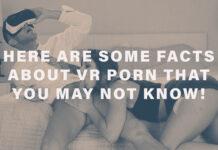Everything You Need To Know About VR Videos
VR Videos – Explained!
Playing and Adjusting VR Videos
What VR headset should I choose to watch Porn?
VR is an emerging medium providing the kind of lifelike experiences people have dreamed of for years. Thousands of creative minds worldwide are doing their best to improve every aspect of the VR eco-system, to the point where you believe exactly what you see in your VR headset.
The most advanced pieces of content can be overwhelming and are highly prized by the VR community, many of whom have been following the technology closely over the past few years. Some aspects still need to be adjusted on user’s side in order to tailor it to your eyes and the way you experience things. Like with every hyped product, with VR videos in general, and VR porn specifically, there’s a lot of speculation and misinformation alongside the intense marketing push.
In this article, we’ll help explain the fundamental things to help you to get the best out of VR. Virtual Reality works best when it makes you feel great when you use it. And it all starts with putting you at the center of the action.
There are some technical things that are good to know that can improve your experience of watching VR videos. With the current state of technology you can be sure to have a mind-blowing experience if everything is done properly, including adjusting settings in your VR video player. The quality of videos can vary widely between different producers. Below you will find a comprehensive explanation to get you all set for the best possible VR video experience. You won’t have to deal with any technical settings when using the SLR app – it automatically adjusts videos so they are optimized for your headset, utilizing presets created by VR professionals to improve the VR aspects of videos.
VR Videos – Explained!

Point of view (POV) VR videos put you at the heart of the experience so you can encounter things from the performer’s perspective. Once you put your headset on you will see things as if you were the person recording the video, with cameras placed where your eyes would be. You will find yourself embodied in a person experiencing pleasure and being at the center of the action, having a perfect sense of presence. Your enjoyment of the video will improve to the degree that you can allow yourself to believe the things you see in front of you. That way you can experience threesome POV, doing cosplay, being on a romantic dinner, etc. Since immersion is such an important part of the VR experience, keep in mind that if you are watching a POV video recorded from lying down position, your experience will be better if you lie down as well. You can also see things from the Female POV, and this could be an exciting surprise for the woman in your life.
In fact, a VR camera could be also positioned in any point of space, allowing you to see how things look from that exact position without a body present. That way you won’t be embodied as participant, but instead enjoy things as a voyeur or a solo experience.
Video resolution is all about the image detail. The current highest quality resolution is around 5760×2880 pixels for a VR video with 180º Field of View (FOV). Videos are known as 5K if either side has around 5000 px, and 4K if around 4000 px. Another popular naming convention is to specify the pixel dimension of the vertical side with a “p” afterwards, making it 2880p, for example. But even with the highest resolution video you might experience poor quality visuals because of the limited resolution of your headset’s display – or if the video player settings are wrong, or due to issues in production. The best resolution currently on the market comes with the HTC Vive Pro and Samsung Odyssey at 2880×1600, and the Galaxy S8/S9 smartphones with GearVR and Daydream headsets. Note, that VR video resolution and VR headset’s resolution are not the same. You watch just a part of the video’s hemisphere projected on headset’s display. It’s a good idea to play video files that have higher resolution than your headset’s display as this gives you a better sense of presence along with more precise detail to the image. If you have problems playing the highest available video resolution because of hardware limitations simply try the next lowest resolution. In the SLR app we recognize your hardware’s performance level and play the best resolution by default.
Be aware that tube sites often provide 720p as the default option in their WebVR video player, which immediately makes for a poor experience. Make sure to switch to higher resolution if available. 1080p is the bare minimum when it comes to a watchable resolution, with the minimum recommendation of 1440p. Quality is crucial in VR and VR needs to be treated in a very dedicated way. Tube sites were designed with other purposes in mind, with VR as a distant afterthought. Also, WebVR players that act as intermediaries only employ VR headsets partial functionality and are not recommended because of major technical limitations, as explained below.
Field of view (FOV) tells what part of the 360º sphere around the user is recorded in the video. While 360º may seem to be the best option, in practice, most studios don’t create content for the viewer to see behind them. This is why the 180º FOV currently dominates VR. Because the activity is limited to a smaller area, studios can provide a better quality image at a smaller filesize. Also, 180º videos are recorded with a duocamera technique that accurately replicates human sight – this means it doesn’t require additional stitching together of footage in post-production. 360º videos, however, can be recorded with up to 16 camera rigs, creating footage that is later stitched together to provide accurate visuals. With the current state of 360º stitching technology and camera alignments it’s hard to get the picture quality as natural as it is with 180º cameras. You might see artifacts such as objects distorting once they get closer to the camera, or certain zones that are not aligned properly. Wide FOV is achieved by using ultra wide-angle fisheye lenses (explained below).
Stereoscopic videos help you perceive things as you would with your eyes in real life. Every moment your brain is fed with slightly different “images” through the retina of your left and right eye, which are then processed by the brain. A VR headset works in the same way by providing slightly different streams for each of your eyes – this is why videos consist of two parts, either Top-Bottom (TB) or Side-by-Side (SBS). If a video has only one stream or two identical streams it’s called monoscopic. With monoscopic video your brain cannot re-create the sense of depth for object displayed on the video. In the earliest days of VR porn, studios experimented with 360 monoscopic video, but it was soon determined that stereoscopic video with performers positioned closer to the camera provided a more immersive and superior experience. Currently, most virtual reality porn videos are produced in 180º stereo rather than 360º mono. The 360 mono format is usually referred as “VR video” in the media, although it is just one of a few approaches currently taken in VR filmmaking. One format may be better suited to reporting news in VR compared to creating a sense of presence in a sex act. You might like to check 360º stereo videos by yourself.
FPS or frames per second rate tells you the framerate and how fast the action in the video was recorded. If it’s not fast enough movements may appear jerky. In most cases 60FPS is the default rate for new videos and it provides very good visuals. However, not every studio can record VR videos in 60FPS and have to use a 30FPS mode due to their camera limitations. That’s why we at SLR use advanced algorithmic tools to interpolate these lower FPS videos to 60FPS, adding frames so your eye won’t see the difference. Not only this, SLR is also the very first site to offer 90FPS videos providing even smoother movement and a more stable image. It is a great option for headsets with a refresh rate of 90Hz like the HTC Vive or Oculus Rift, while Samsung Galaxy and iPhones are at 60Hz.
Bitrate tells us how many bytes were used to provide the given resolution. In general, the higher bitrate the better quality image, although newer codecs like H.265 can provide much higher quality at a lower bitrate. The current standard is 30Mbps which is more than the minimum required for 180º 5K stereoscopic video at 60FPS.
Filesize: VR videos have much higher specifications for resolution, field of view, bitrate and FPS than regular flat videos, and this is why you end up with a 6-10GB file for a 30 minute video. It might be problematic to store a dozen such videos on your phone or portable VR device like Oculus Go. We recommend you use the SLR app – this streams videos at lightning fast speed, ensuring you won’t have any capacity issues. Although there’s no difference in the perceived quality of a video streamed in SLR app compared to watching a downloaded video at the same resolution, the app also allows you to download rather than stream these files. Next time you hit a video in the app it will be played from downloaded file rather than streamed. We are implementing a feature that will allow you to send videos on the website to the app in your headset to make you all set for travelling.
A codec is used to compress huge raw video files into downloadable files. Currently h.265 and h.264 are the most popular ones. Each one has its own specifics and compatible hardware. The general rule is h.265 is more advanced and provides better quality along with a smaller filesize. It’s the default for Android phones and newer GPU’s, while some older GPU’s and PSVR can process h.264 only. SLR is the only site that provides videos in both versions of the codec. The SLR app automatically plays the videos with the best performing codec for your VR headset. It’s important to note that Windows 10 Home edition has a problem playing h.265 videos.
Other kind of codecs (like those in LAV Filters) allow the playback of high quality VR videos on Windows along with various audio formats and are required to be additionally installed.
VR video production is a complex process for both filming and post-production. Most producers use custom DIY camera rigs to shoot VR, with their own approach to storytelling and post-production techniques as there is no definitive rulebook how to do these things correctly in VR. This is why the quality varies between content producers. Scaling issues (enormous proportions of people and objects), distortions, and vertical and horizontal mis-alignments impaired the first generation of VR videos, but on the whole this has been fixed. Though proper vertical and horizontal alignments(explained below in the “Video Player” section) are still proving challenging for many studios.
Don’t be alarmed the next time you see something is flawed about a video from a top VR porn studio – it might be a video recorded back when the technology was not as advanced as it is now. Make sure to check when the video was released, as in the vast majority of cases, newer videos are of significantly better quality. The modern style of production can still be improved or enhanced to provide a more realistic experience – as such, SexLikeReal edits the master videos for a number of studios so that their videos have perfect stereoscopic alignments (these videos are tagged with “SLR Mastering”). Refer your favorite studio to us so we can enhance the quality of their videos.
VR videos are captured using FishEye lenses, the ultra wide-angle lenses, to create a wide panoramic or hemispherical image. That mapping is called fisheye projection and requires a proper mesh to be displayed in VR to eliminate distortions from the center to edges within the image obtained from a camera with a wide-angle lens. Raw video footage is always obtained in fisheye. If no further conversion is done VR videos get stored in this projection and includes variations of the lens curvature used during filming. This causes problems when it comes to video playback. Later, content producers started to export videos to a standardized equirectangular projection – this is commonly used these days and does not require amendments when it comes to playing the footage. Youtube videos are projected by equiangular Cubemap (EAC).
DeoVR is the only VR video player supporting fisheye videos with proper mesh you can select in settings. SLR app is programmed in advance with a few dozens of presets and proper plays fisheye videos with no additional user inputs required.
Lightfield video technology is the next generation of VR videos. It is based on capturing light with multiple cameras and recreating it in VR so you can see things from different perspectives – this is also called six degrees of freedom (6 DoF). Here, you can move your head all around and see things as you would see in real life. It’s similar to seeing reflections in a mirror from different angles while moving around in front of it. The Welcome to Light Fields demo gives a good sense of how this works.
Playing and Adjusting VR Videos

To play VR videos you need a video player designed for virtual reality and optimized for playing the types of videos and video formats you want to experience in VR. We recommend DeoVR which has the best performance for every VR headset. You simply have to specify whether the video is Top-Bottom or Side-by-Side and 180º or 360º.
There might be some flaws in production and post production that could be “fixed” in the player’s easy to access settings panel. If an image seems off, vertical and horizontal offsets let you adjust the left and right camera to make them perfectly aligned to your eyes. Even a small mis-alignment may cause the brain to process video improperly and it may make the experience feel unpleasant.
People have variable distances between their eyes called interpupillary distance (IPD). The left and right production cameras for stereoscopic video are set in a fixed position while filming of around 65mm (the human average). As everyone is different, you might like to adjust distance between cameras to align closer to that of your own eyes.

Many videos are significantly enhanced once the proper VR video player settings are in place. Once set, settings are saved by player in presets for every particular video. All these settings also can be adjusted in the SLR app, which contains a version of the DeoVR player:
- Zoom: gets you closer to, or further from, the objects you see in the video. This feature is most useful when compensating for scaling issues in filming which might result in objects being a bit too large or too small. You can also enjoy getting closer to an action using this function.
- Tilt allows you to rotate the scene to match your body position or fix “sloping” floor problem in the video.
- If you see people and objects having “phantom” or repeating image of their parts, in most cases it’s a vertical misalignment issue that could be fixed with vertical offset. Proper vertical alignment is very important for perception and is required to be set precisely. On the SLR app vertical and horizontal mis-alignments are corrected by editors and videos are pre-adjusted with proper offsets.
- Horizontal offset aligns distance between the right and left eye. Your brain does a great job at handling stereoscopic videos that have slightly different IPD than your eyes, it can handle horizontal offset easier than vertical mis-alignments. Still, the cameras might be too far away or too close to each other resulting in imperfect conversion that might be improved with proper horizontal offset settings. If there is a major horizontal mis-alignment, forced monoscopic might be the only good option, effectively duplicating a single image for both eyes to avoid an unpleasant stereoscopic effect.
- Height: changes height of viewing position. Helpful if the camera was too low or too high compared to your head’s desirable position. This also allows you to change the perspective at which you look at things.
- Saturation: allows you to adjust colors to make the picture more pleasant to your eyes, such as making body colors look more natural.
- Sharpness: helps provide better clarity for the image.
- By enabling “Fish-eye” option you can watch fish-eye videos without distortion. Fish-eye was a typical projection for VR videos in the first few years of production. No other VR video player has this function.
- Head tracking provides additional degrees of freedom and makes videos more realistic as you can interact with the video simply by using your natural head movements. You can zoom in and zoom out of videos in three directions by leaning your head.
WebVR is a protocol and technology that lets the user watch VR videos or other content via a web browser, as an alternative to downloading files or streaming within the SLR app (which has native application for every VR platform and works in a different way). This video is played with WebVR video player in a Youtube-like web interface. WebVR has serious limitations and is not suitable for high performance VR videos because of lower resolution, higher latency and limited functionality. In comparison, videos played using the SLR app provide much better quality and immersion as it has direct access to the hardware and utilizes its technical capability much better. Most WebVR video players on tube sites are configured to have low 720p resolution by default, providing a substandard experience. Make sure to switch to the highest available resolution that your device supports.
The iTunes-like SLR app provides over 20,000 of daily users with all the VR porn videos they could possibly desire. No need to surf through dozens of content producers and downloaded trailers before finding one you like. With a single click you can navigate through over 5,000 videos, plus around 10 new videos are released each day. SLR is an in-VR browser and video player connected to a vast library of adult VR content. It automatically selects one of 30 VR video formats to play in your headset, always at the best quality for your VR set-up. Many videos have presets established within the player that make the visual experience much better than downloading the same video. The SLR app is designed so that your VR headset is fully utilized for the best performance, thus native application is provided for every headset. While there’s no difference in the perceived quality of a video at the same resolution streamed in SLR app or watched from a downloaded file, the app also supports file downloading. Next time you hit a video in the app it will be played from downloaded file rather than streamed.
We would like to have the SLR app in app stores, but because adult content is prohibited on there you have to download it from our website. Don’t worry, the app is very secure and discreet. PIN protection is a feature we will announce soon.
Here are some typical comments about SLR app:
- “Discovered the SLR app last month and my mind was blown. First time I’ve ever paid for porn, and it’s been worth every penny many times over. If more people tried it VR would really take off. Not gonna see them demoing that in Best Buy stores any time soon though. XD” – PM_ME_UR_COCK_GIRL
- “Man the app is more fluid than most oculus apps I use” – Meowjin
- “You player is actually the best one available! Don’t ever take away the tilt and zoom, from the analog stick (in real-time), it is a fantastic feature and the reason I use your player to even watch SFW videos every time” – Rodec
- “Just wanted to post here about how amazing the new SLR app is. Can’t wait for official release, but the beta is just about perfect”– JitWeasel
What VR headset should I choose to watch porn?

To watch VR videos you can choose from:
- Desktop powered headsets like the Oculus Rift, the HTC Vive (Pro version has the best resolution), the Samsung Odyssey or Windows Mixed Reality headsets – all have similar specs, and are produced by Acer, Lenovo, HP, Dell. You need a powerful computer to run these. The 90Hz headsets with proper GPU are capable of playing the highest performance videos, including 5K 90FPS. They also give you an option to enjoy state of the art VR games, including those at GameVirt.
- Premium phone based headsets like the Samsung Gear VR or Daydream are compatible with selected high performance smartphones. You simply put your smartphone into the headset and watch state of the art videos. Samsung Galaxy S8/S8+ and S9/S9+ are the best choices, with great displays that work with both types of premium headset. Asian and European versions of those phones have the Exynos chipset that is even capable of playing 5K/6K videos.
- Stand alone headsets like the Oculus Go for $199 are great for watching videos, though many aren’t able to play 5K videos. Oculus Go also prohibits unauthorized applications from being installed in an easy way. You need to follow these instructions to get the SLR app running on Go.
Not recommended:
- Cardboard headsets allow you to use almost any modern phone to watch VR. Lower performing smartphones might not be able to play high resolution and high FPS videos. Also these headsets are the least convenient when it comes to everyday use. Cardboard blueprints are manufactured by multiple producers, so the quality varies a lot. Also there are many cardboard headsets developed by independent companies that might not support many VR features or specs. You might be very disappointed by purchasing one type of cardboard headset, or very happy with a decent one that fits your phone. Cardboard headsets are the only option for iPhones.
- iPhones, including the most recent iPhone X model, are not the best option to watch VR, because of the low resolution and high latency of their display screens. 5K quality videos do not work either – but 4K videos play fine, on the iPhone 7 and above. Google Cardboard or their variants like the Homido VR headset are the only option, which are inferior to the GearVR or DayDream headsets. Also the SLR app and explicit VR games can not be installed on iPhones because Apple prohibits adult content. The DeoVR player is the best option to watch VR videos on iPhone.
- Playstation VR (PSVR) has low resolution and is more complicated to use to watch VR videos because of the closed eco-system which hosts only one video player. It’s also problematic to get any explicit VR games on this system. But you still can enjoy VR videos if you already have PSVR. Make sure to check: How to watch porn on PSVR. The PS4 Pro is more suitable for VR porn videos than the PS4 but even the PS4 Pro is only capable of 2040p at 60fps. At SLR we optimize every video to meet the best possible specs for PSVR, both PS4 and PS4 Pro.















